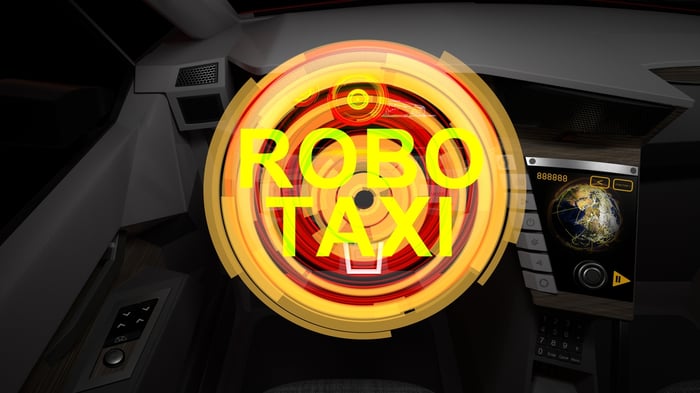|
|
|

|
|||||

|
|
The robotaxi is the best way to maximize the economic value of an EV.
Robotaxis are an integral part of the EV industry, which is why Tesla's rivals have invested billions in developing them.
Tesla is a speculative investment, but it's one backed by a dominant market presence.
Investing in Tesla (NASDAQ: TSLA) these days requires a reset of investor perspectives on what the company is and what kind of industry it operates in. Keeping that premise in mind, here's one view of Tesla, its industry, and the investment proposition for the stock.
Traditionally, investors viewed the auto industry as a highly competitive, mature, low-growth, and relatively low-margin sector, and accorded stocks in the industry the kind of low valuations that such stocks deserve. After all, having to develop new models every five to seven years and refresh them every few years is costly, as consumer preferences change and competitors introduce new models. Additionally, automakers strive to generate revenue from after-sales services, encompassing financing, parts, and maintenance.
Where to invest $1,000 right now? Our analyst team just revealed what they believe are the 10 best stocks to buy right now. Learn More »

Image source: Getty Images.
However, this traditional business model is challenged by EVs for the following reasons:
As such, if EVs are the future, and an automaker wants to remain relevant to that future, then it must find a way to reduce the upfront costs of EVs. It also needs to develop a way of generating recurring after-sales revenue. Tesla thinks it has the answer to both questions.
Recognizing that EVs will have relatively higher upfront costs but significantly lower fueling and maintenance costs compared to internal combustion engine (ICE) cars, the auto industry's solution is to capitalize on the natural economic advantages of EVs, which distinguish them from ICE cars. The following table helps summarize matters.
| Electric vehicles | Internal Combustion Engines | |
|---|---|---|
| Upfront costs | High | Low |
| Fueling costs | Low | Higher (depending on oil prices) |
| Maintenance costs | Low | High |
| Economic value generation | Run often over many years | Lower upfront costs |
Data source: Table by author.
Tesla has three solutions.
All of which leads to the first honest opinion of Tesla.
The robotaxi concept is not a "moonshot" for the company or the industry; it's an integral part of the future of the automotive and electric vehicle (EV) industry, and Tesla is leading the way.
All of the above is well known in the industry; it's why Ford Motor Company is investing $5 billion in EV development, and why legacy automakers continue to invest billions in loss-making EVs to try and take market share. It's also why automakers like Ford, GM, Volkswagen, and others have previously invested billions in developing autonomous driving software and robotaxis. Additionally, tech companies like Alphabet (Google's Waymo) and Amazon (Zoox) have invested billions in autonomous vehicle ventures.
While there's a reason why many companies have invested heavily in autonomous driving and robotaxis, there's also a reason why some, like GM, have abandoned robotaxi development and why Ford and Volkswagen pulled the plug on investing in Argo AI, a company developing autonomous vehicles.
It's not easy to do, especially if you are a minor player in the EV market.
Tesla is not a minor player in EVs. In fact, despite declining sales due to rivals effectively subsidizing loss-making vehicles, it still has a dominant market share in the U.S. It has a fleet of cars to gather vast amounts of data to improve FSD, and its robotaxi rollout, which began in 2025, is underway.
Tesla is a speculative growth stock, but it has significant advantages over most growth stocks, including leading market share and a potentially cost-effective robotaxi/unsupervised FSD offering.
While recurring revenue from robotaxis and unsupervised FSD, as well as Cybercab sales (volume production is planned for 2026), are promising, none of these initiatives have come to fruition yet, and significant technological and regulatory hurdles remain to be overcome.

Image source: Getty Images.
It's a speculative growth stock, with a valuation to match. There are no guarantees around robotaxis and unsupervised FSD approval, and CEO Elon Musk has a history of being overly optimistic on the matter.
That said, it's where the industry is headed, and where most of the legacy automakers wanted to be. As such, Tesla is a high-risk/high-reward stock, but such stocks deserve a place in a portfolio, just perhaps not as a core holding for most investors.
Ever feel like you missed the boat in buying the most successful stocks? Then you’ll want to hear this.
On rare occasions, our expert team of analysts issues a “Double Down” stock recommendation for companies that they think are about to pop. If you’re worried you’ve already missed your chance to invest, now is the best time to buy before it’s too late. And the numbers speak for themselves:
Right now, we’re issuing “Double Down” alerts for three incredible companies, available when you join Stock Advisor, and there may not be another chance like this anytime soon.
*Stock Advisor returns as of September 22, 2025
Lee Samaha has no position in any of the stocks mentioned. The Motley Fool has positions in and recommends Alphabet, Amazon, and Tesla. The Motley Fool recommends General Motors and Volkswagen Ag. The Motley Fool has a disclosure policy.
| 6 hours | |
| 6 hours | |
| 7 hours | |
| 8 hours | |
| 9 hours | |
| 9 hours | |
| 9 hours | |
| 9 hours | |
| 9 hours | |
| 10 hours | |
| 11 hours | |
| 11 hours | |
| 11 hours | |
| 11 hours | |
| 12 hours |
Join thousands of traders who make more informed decisions with our premium features. Real-time quotes, advanced visualizations, backtesting, and much more.
Learn more about FINVIZ*Elite